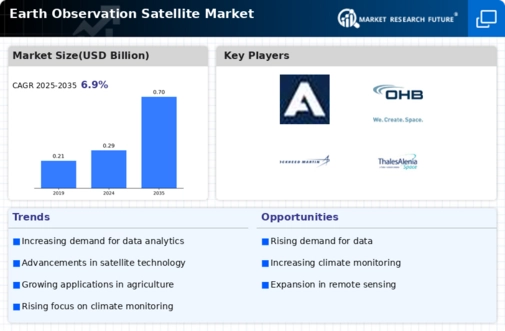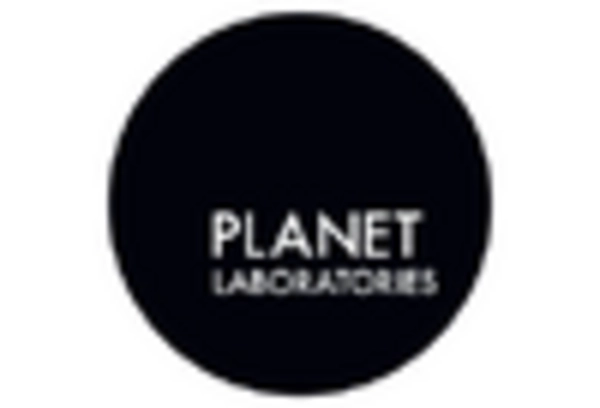Market Share
Introduction: Navigating the Competitive Landscape of Earth Observation Satellites
The Earth Observation Satellite market is witnessing unprecedented competitive momentum, driven by rapid technology adoption, evolving regulatory frameworks, and heightened consumer expectations for real-time data accessibility. Key players, including OEMs, IT integrators, infrastructure providers, and innovative AI startups, are vying for leadership by leveraging advanced capabilities such as AI-based analytics, automation, and IoT integration. These technology-driven differentiators are not only enhancing operational efficiencies but also reshaping market share dynamics as companies strive to offer superior data insights and service reliability. Furthermore, regional growth opportunities are emerging, particularly in Asia-Pacific and North America, where strategic deployment trends are focused on enhancing green infrastructure and sustainability initiatives. As we look towards 2024-2025, understanding these competitive dynamics will be crucial for C-level executives and strategic planners aiming to capitalize on the transformative potential of Earth Observation technologies.
Competitive Positioning
Full-Suite Integrators
These vendors provide comprehensive solutions encompassing satellite design, manufacturing, and operational services.
| Vendor | Competitive Edge | Solution Focus | Regional Focus |
|---|---|---|---|
| Airbus Defence and Space | Strong European presence and partnerships | Satellite systems and services | Europe, Asia, Americas |
| Boeing Defense Space & Security | Robust aerospace engineering expertise | Defense and commercial satellites | North America, global |
| Lockheed Martin | Advanced technology integration capabilities | Satellite systems and defense solutions | North America, global |
| Thales Alenia Space | Strong focus on innovation and R&D | Satellite systems and payloads | Europe, Asia, Americas |
Specialized Technology Vendors
These vendors focus on niche technologies and solutions within the Earth observation satellite market.
| Vendor | Competitive Edge | Solution Focus | Regional Focus |
|---|---|---|---|
| Space Systems/Loral | Expertise in commercial satellite manufacturing | Satellite design and manufacturing | North America, global |
| Space Exploration Technologies Corp. | Innovative launch capabilities and cost efficiency | Launch services and satellite deployment | Global |
Infrastructure & Equipment Providers
These vendors supply essential infrastructure and equipment for satellite operations and data processing.
| Vendor | Competitive Edge | Solution Focus | Regional Focus |
|---|---|---|---|
| OHB SE | Strong capabilities in small satellite technology | Satellite systems and components | Europe, global |
| JSC Information Satellite Systems | Expertise in satellite control systems | Satellite systems and ground control | Russia, global |
| Orbital ATK | Integrated solutions for satellite and launch systems | Satellite systems and launch vehicles | North America, global |
Emerging Players & Regional Champions
- Planet Labs (USA): Specializes in high-frequency Earth imaging with a fleet of small satellites, recently secured contracts with various governmental agencies for agricultural monitoring, challenging established players like Maxar by offering more frequent data updates at lower costs.
- ICEYE (Finland): Focuses on synthetic aperture radar (SAR) technology for all-weather imaging, recently partnered with the European Space Agency for disaster monitoring projects, complementing traditional optical satellite providers by offering unique capabilities in adverse weather conditions.
- Satellogic (Argentina): Provides high-resolution Earth observation data with a focus on environmental monitoring, recently expanded its satellite constellation to enhance coverage in Latin America, positioning itself as a regional champion against larger competitors by focusing on niche markets.
- BlackSky (USA): Offers real-time geospatial intelligence with a focus on rapid revisit times, recently entered into a contract with the U.S. Department of Defense, challenging established vendors by providing timely data for defense and intelligence applications.
- Spire Global (USA): Utilizes a unique combination of satellite data and analytics for maritime and weather tracking, recently launched a new satellite dedicated to climate monitoring, complementing traditional Earth observation firms by integrating data analytics with satellite imagery.
Regional Trends: In 2024, there is a notable increase in regional adoption of Earth observation technologies, particularly in developing regions such as Latin America and Africa, where governments are investing in satellite capabilities for environmental monitoring and disaster response. Additionally, there is a trend towards specialization in niche applications, such as agriculture, climate change, and urban planning, with emerging players leveraging innovative technologies like SAR and small satellite constellations to provide tailored solutions.
Collaborations & M&A Movements
- Maxar Technologies and Airbus Defence and Space entered into a partnership to jointly develop advanced Earth observation solutions, aiming to enhance their competitive positioning in the global satellite imagery market.
- Planet Labs PBC acquired the satellite data analytics firm, Terra Bella, in early 2024 to expand its capabilities in providing high-resolution imagery and analytics, thereby increasing its market share in the Earth observation sector.
- Northrop Grumman and the European Space Agency (ESA) collaborated on a project to improve satellite communication technologies, which is expected to strengthen their positions in the growing market for Earth observation data services.
Competitive Summary Table
| Capability | Leading Players | Remarks |
|---|---|---|
| High-Resolution Imaging | Maxar Technologies, Planet Labs | Maxar Technologies offers advanced imaging capabilities with resolutions as fine as 30 cm, widely adopted for urban planning and disaster response. Planet Labs provides daily global coverage with its Doves constellation, enabling timely data for agriculture and environmental monitoring. |
| Data Analytics and Processing | Airbus Defence and Space, BlackSky | Airbus integrates AI-driven analytics to enhance satellite data interpretation, supporting sectors like defense and agriculture. BlackSky focuses on real-time analytics, providing actionable insights for businesses and governments, exemplified by their rapid response to natural disasters. |
| Multi-Spectral and Hyperspectral Imaging | NASA, European Space Agency (ESA) | NASA's Earth Observing System satellites utilize multi-spectral imaging for climate research, while ESA's Sentinel missions employ hyperspectral sensors for environmental monitoring, showcasing their commitment to scientific research and sustainability. |
| Satellite Communication | Iridium Communications, SES S.A. | Iridium provides global satellite communication services with low-latency connections, crucial for remote operations. SES S.A. leverages its geostationary satellites for high-throughput connectivity, supporting various industries including maritime and aviation. |
| Sustainability and Environmental Monitoring | Planet Labs, NASA | Planet Labs focuses on sustainability by providing data for carbon tracking and land use changes, while NASA's Earth science missions contribute to climate change research, demonstrating a strong commitment to environmental stewardship. |
Conclusion: Navigating the Earth Observation Landscape
The Earth Observation Satellite Market is characterized by intense competitive dynamics and significant fragmentation, with both legacy and emerging players vying for market share. Regional trends indicate a growing emphasis on sustainability and environmental monitoring, prompting vendors to adapt their strategies accordingly. Legacy players are leveraging established infrastructures and expertise, while emerging companies are focusing on innovative capabilities such as AI and automation to differentiate themselves. As the market evolves, the ability to offer flexible solutions that integrate advanced technologies will be crucial for leadership. Vendors must prioritize investments in AI-driven analytics, automated data processing, and sustainable practices to meet the increasing demands of diverse customer segments and maintain a competitive edge.

















Leave a Comment